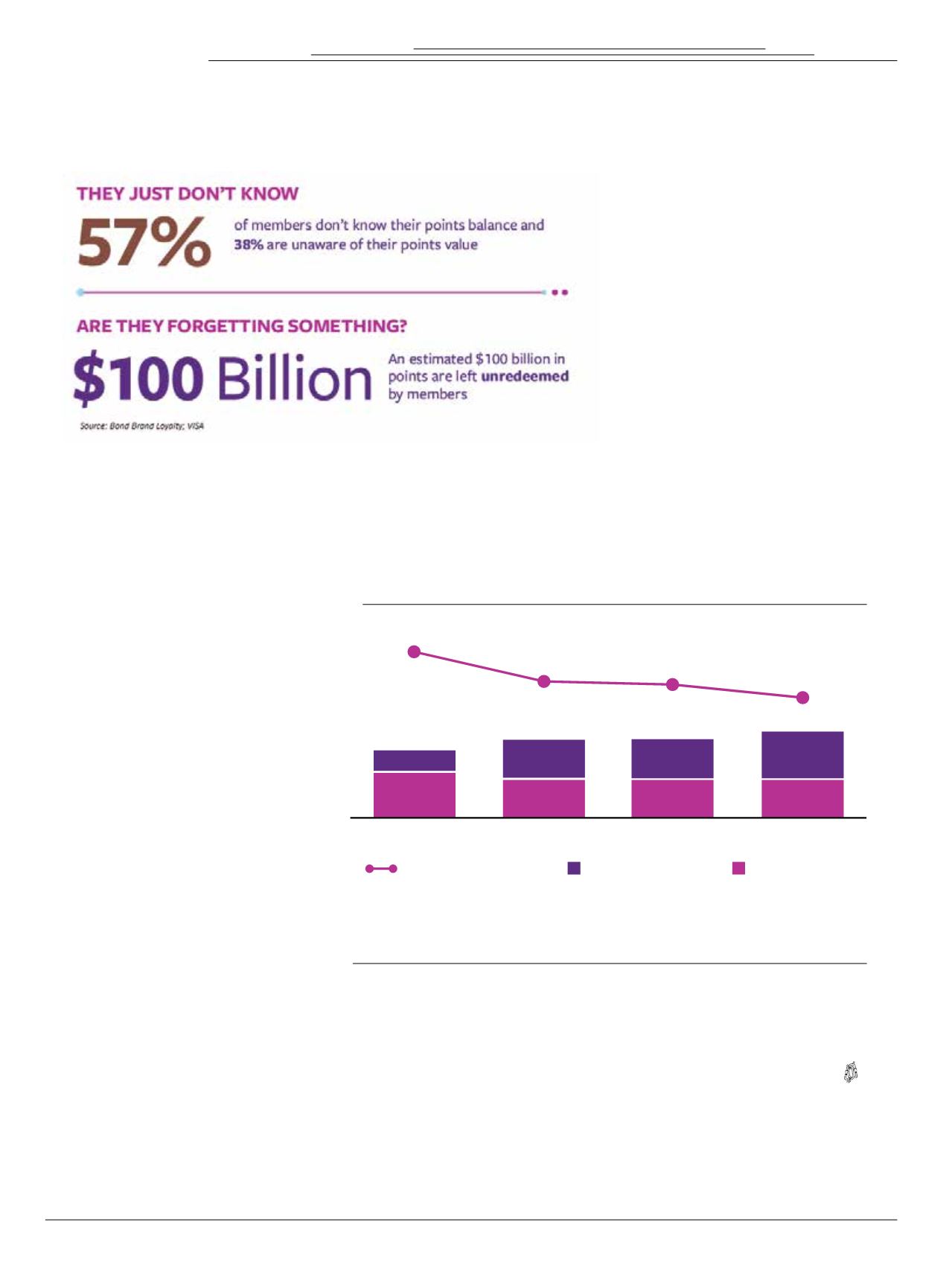

particular purchase that day you were
supposed to use it on a future trip to the
store. Understandably, it was a point of
contention with some customers.
Several stores had “use it or lose
it” caveats similar to flexible benefit
programs. One retailer I spoke with
discovered that only 50 percent of
those entitled were actually using the
benefit. Other point programs have
expirations dates ranging from 90
days to a year to never.
Another store merchandise manager
told me that their system required a lot
of maintenance and backend confu-
sion and went on to say, “Personally, it
doesn’t drive me to shop.” When asked
if she would have a similar program if
she owned the company, the answer
was a resounding “no.”
Ideas to consider instead
of tracking points
Some stores feel that having fre-
quent sales and promotions where
good customers can benefit from extra
savings provides sufficient value. Oth-
ers find that using coupons in various
denominations with tight usage win-
dows are better motivators. Additional
options to consider, in lieu of buyer
programs, might include gift-with-
purchase or purchase-with-purchase
ideas, a marketing concept popular-
ized and still very much in use today
by cosmetic companies. I have had
stores tell me that they experience
very strong response and much better
than average return to customer ap-
preciation letters. These are sent out
annually with varying dollar amounts
based on how much the customer has
spent the previous year. (Customer
appreciation letters are very effective
if set up correctly, and implementation
isn’t difficult or time consuming, but
we’ll leave that for a future column.)
In the end, a retailer should regu-
larly review the true value of any fre-
quent buyer program by looking at
all facets. Are customers really more
loyal to the store because of them?
Are frequent buyer programs becom-
ing generational? Meaning do they
appeal to certain age demographics
more than others, say customers over
age 40? Should credit be given on all
purchases or just full price?
If every store has a program, does
it really make a difference? Is our pro-
gram simple to manage and easy for
the customer to understand? An argu-
ment could be made that customers
should be shopping your stores be-
cause they enjoy the experience, your
people, and the selection of merchan-
dise and not simply because they rack
up frequent buyer points that at least in
some cases go unused.
When you embark on a new buyer pro-
gram, remember it is always easier to add
more later than to take things away, if you
come to the realization that your program
is becoming cost prohibitive. Strongly
consider awarding points on full-price pur-
chases only to help minimize costs. When
associates fill out a new customer profile
for a buyer program, they must have at
a minimum name and email address.
Additionally, mailing address and phone
number would also be helpful. With that
information, you will at least have a tool
to reach out to them in the future.
If you have a frequent buyer pro-
gram, review it today and be sure to
find out how much you are giving away
in reward dollars. If you are considering
one of these programs, you must do
your homework or run the risk of hav-
ing to answer the question Connie
Francis posed back in 1958 when she
crooned … “Who’s sorry now?”
Ritchie Sayner is the author or “Re-
tail Revelation –Strategies for Improving
Sales, Margins, and Turnover,” avail-
able from Amazon. He can be reached
at
RSayner@rmsa.com.BACK
OFFICE
Source: Physical Activity Council
Loyalty Memberships Up, Engagement Flat
Source: Bond Brand Loyalty; VISA
0%
10%
20%
30%
40%
50%
60%
48.1%
42.9%
32.9%
31.8%
25.1%
24.9%
19.3%
20.1%
18.8%
18.6%
18.5%
17.3%
16.3%
16.6%
14.8%
13.7%
12.6%
11.6%
12.4%
11.7%
11.8%
11.7%
7.8%
7.7%
17.1%
17.3%
Having someone to take part with
Having a friend take me along
Being in better health
More vacation time
Fewer work commitments
Having an introductory
lesson or outing
Fewer family commitments
2014
2015
Having a friend instruct me
Having a tax break on equipment,
membership, fees and insturction
Availability of better
multi-use trails and sidewalks
to my heighborhood
New equipment
Having the activity sponsored
by my employer
Something else
72%
47%
14.3%
6.7%
10.9
7.8
2014
2015
2016
2017
% Active Memberships
Total Memberships
Active Memberships
Since 2014 study, the average number of program memberships per American consumer
has increased steadily from under 11 to more than 14. Meanwhile, the number of programs
in which members are active is virtually unchanged at just under 6.7 (47%).
!
!
Inside
Outdoor
|
SUMMER
2017
24
















